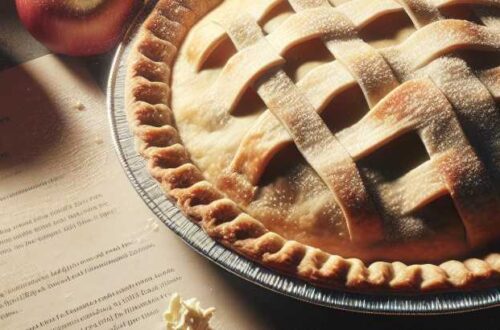Types of Flour and Their Uses

1. Differentiating Whole Grain, White, and Gluten-Free Flour
Title: The Diverse Universe of Flour: An Epicurean Adventure into Whole Grain, White, and Gluten-Free Flour
Grab a knapkin, folks, because things are about to get unexpectedly flaky, surprisingly grainy, and amusingly gluten-free! In the roller-coaster culinary cosmos, flour is often regarded as one kitchen star that shuns the limelight, but without which, the food universe would undeniably taste less heavenly. Hold on to your spatulas as we dive headfirst into the culinary clash of Whole Grain, White, and Gluten-Free Flour!
Our epic story begins in the rustic fields of the Whole Grain Empire. This robust, hardy flour is the Hercules of our gastronomic gladiators—a true might of nature, whole grain flour proudly dons every part of the grain—the bran, endosperm, and germ. Whole grain flour has a distinct down-to-earth taste, adds a rich texture to your baked goods, and hits your palate with a hearty ‘HOWDTY!’ Like a considerate gym buddy, it also packs a healthy punch. High in protein, fiber, and other nutrients, whole grain flour is the friend you want by your side during those early morning yoga sessions or late-night cookie-baking extravaganzas.
Next on our roller-coaster ride, allow me to introduce our sultry starlet, the dazzling White flour. Stripped off its ‘grainy’ exterior, this superstar has been refined to bring out the pure, starchy endosperm. White flour rolls out the red carpet for a smoother texture and a milder flavor. If whole grain flour is the funky jazz musician, then white flour is the smooth crooner, serenading your taste-buds with easy-to-bake, fluffy confections. But beware! Our elegant diva may promise fluffy baked goods that melt like cotton-candy dreams in your mouth, but with all the refining and processing, some useful nutrients often end up on the cutting room floor.
Finally, the plot twist – Gluten-Free flour! This enigmatic powerhouse defies the norms and rebels by saying ‘no’ to the protein gluten, common in wheat, barley, and rye.
“I suppose that somewhere, deep down in his nature, there lurked a grain of superstition, which found in this singular coincidence, this sudden stringing together of persons long parted, an evil omen”
~ Stanley J. Weyman, Shrewsbury
Gluten-free flour dances to its colorful beat with a melange of grains and seeds like almond, rice, corn, and even unexpected entrants like beans and potatoes! It’s like a culinary mosaic that opens a whole new arena of flavors and textures. Ideal for those with celiac disease or wheat allergies, gluten-free flour is the silent champion catering to dietary needs like a discreet, diligent butler. Remember though, crafting the perfect gluten-free treats may require some trial, error, and a dash of sorcery!
So, there we have it—the gastronomic tour de force of Whole Grain, White, and Gluten-Free Flour. Each is unique with its characteristics, strengths, weaknesses, and culinary superpowers. Whether they are kneading out good health, whipping up fluffy delights, or championing dietary restrictions, these unsung heroes of the culinary world add a sprinkle of magic to your kitchen encounters.
Ladies and Gentleman, it’s time to detach from the abstraction of flour and embrace the wonder of al dente pasta, golden-brown bread, and heavenly cakes. Whatever your choice, remember: life is a recipe requiring different types of flour. So, pick your ingredient and let’s get baking!
Source: 1. Differentiating Whole Grain, White, And Gluten-free Flour

2. Uses and Applications of Specialty Flours
Title: The Mill-Spinning Magic of Specialty Flors: Not Just for Mills and Bakeries!
Introducing the unsung heroes of the kitchen – Specialty Flours! They may seem like the Clark Kents of the culinary universe – quiet, unassuming, and omnipresent on the pantry shelf. However, when the apron’s tied and the oven’s humming, they reveal their super baking powers.
From breads that could win beauty pageants, to pastries that bring tears of joy, these flours are not your ordinary run-of-the-mill–pun intended–cereal ground. Let’s dredge up the fascinating uses and applications of these extraordinary powders.
1. The Coconut Flour Chronicles:
Ah, coconut flour! Made from the musical fruit (coconuts, for the uninitiated) it’s the Elvis Presley of flours – slick, smooth, and often leaving bakers ‘All Shook Up’! It’s as if a bunch of coconuts got together and said Let’s see how versatile we can get, shall we? If you’re jiving to a gluten-free beat or just looking to add moisture and a tropical hum to your dishes, Coconut Flour is your main squeeze. From pancakes that taste like an island holiday to muffins that moonwalk across your taste buds, the coco-can-do attitude of this flour is impressive.
2. The Almond Flour Fanfare:
Ladies and gentlemen, step up for the golden child of the health-conscious baking world, the almond flour! Created from finesses of blanched almonds, this flour introduces the nutty flair to your delights, leaving your guests ‘oohing’ and ‘ahhing’. It has the buttery hug of almonds combined with a comforting warm smoothness which makes it sit pretty in cookies, macarons, and cakes. Plus, it whispers sweet nothings to gluten, sugar, and carbs – making it the 007 of healthy flour spies.
3. A Tad about Tapioca Flour:
Let’s stray into the rainforests of Brazil, where the cassava plant first soliloquized To be or not to be a flour! Tapioca flour is its starchy success story, a smooth operator that binds, thickens and adds chew to culinary masterpieces.
“”Captain Nathan Smith is to march to Pawlet on horseback with the men under his command and there receive a horse Load of Flours to Each man and horse; and Captain Wood is ordered to take charge of the same, and without one minute’s loss of time proceed to Pawlet and thence to Colonel Warner.””
~ Rowland E. Robinson, Vermont
Gluten-free breads and pizzas adore it, while pies and pastries bow in the face of its top-notch thickening powers. It’s the undercover agent in your recipe, mingling so seamlessly that you’ll never be able to tug it out of the taste lineup.
4. Raving about Rice Flour:
With an earthy taste and a slight graininess, rice flour is like your favorite pop song – familiar, yet packed with hidden layers of fun! Derived from finely milled rice, it’s lighter, fluffier, and gives your baked goodies a tender nudge. It rules the roost in Asian cuisine with delightful dumplings, creamy noodles, and impeccable tempura batter dancing enchanted by its tune.
At the end of the day, these specialty flours know how to party. Armed with unique characteristics, numerous health benefits, and joyous versatility, they can add an exciting twist to the most mundane of meals.
So the next time you roll out your baking mat, dare to reach out for these fun flours. Who knows, your cookies might just rise up and sing, or your pizza crust could do the cha-cha. At the very least, your taste buds will thank you for the delicious journey!
Remember, everything tastes ‘flour-tastic’ when you switch out the mundane, embrace the extraordinary, and bake with a cup full of love and a dash of laughter. Happy baking, folks!
Read More: 2. Uses And Applications Of Specialty Flours

3. Understanding Nutritional Differences Among Flour Types
Title: The Great Flour Power – Understanding the Nutritional Differences Among Flour Types
Ever wondered what separates the All-Purpose Michael from the Whole Wheat Wendy? Or why Almond Alice is a little bit nutty, and Rye Roger is robustly rustic? If you’re kneading answers to these grainy mysteries—you’re in good company! Buckle up, breadheads! It’s time to separate the wheat from the chaff and get to the root of all things flour.
First off, we’ve got the quiet extrovert of the flour world, the White All-purpose flour. Sitting casually at the intersection of ‘I can do everything’ and ‘I am everywhere’, this flour defines versatility serving as the backbone of many a cookie, cake and crust. Nutritionally speaking, All-Purpose flour doesn’t steal the show. It’s the reliable sidekick, not the superhero—so don’t expect a smorgasbord of nutritional richness. The milling process strips most of the fiber, iron, and B vitamins, leaving this flour sitting comfortably in the ‘refined’ category.
Then, there’s the friend we all need but often ignore, Whole Wheat Wendy. She’s like the friend who insists on eating a salad while everyone else is pigging out on pizza. She might seem a bit boring, but Wendy is actually packed with nutrients! This flour type is made from grinding the whole grain, including the bran, germ, and endosperm. This means its fiber content is off the charts, it brings a laundry list of necessary and healthy nutrients like potassium, magnesium, and iron to the table, and its dense texture brings depth to every dish.
Moving along to our milk of magnesia, Almond Alice. Oh, Alice! You might think she’s floundering in the wrong domain with her nutty heritage and all, but she’s got something unique.
“”If you reduce it to a mere question of avoirdupois, please be so good as to remember that even greater differences exist among men.””
~ Augusta J. Evans, St. Elmo
Made purely from ground almonds, Almond flour is gluten-free, low in carbs, higher in protein and fat and reigns supreme in the Vitamin E and magnesium arena. Could she get any better? Combine all this nutritional glam with her naturally sweet and nutty flavor, and she’s the belle of the gluten-free ball!
Last but certainly not least, we’ve got Rye Roger, the rustic rogue of the flour family. Rye flour, with its edgy and strong personality, doesn’t just fit any recipe. But boy, when he fits, he shines! On the nutritional front, Rye is uniquely dense bringing higher fiber content and a long list of nutrients, like manganese, phosphorus, and zinc.
To sum up: All-purpose flour is your go-to, Jack-of-all-trades, average Joe. Whole Wheat Wendy is your nutrient-dense, healthy friend. Almond Alice is a starlet with her low carb, high vitamin profile, and Rye Roger, he’s the broodingly rugged type with his unique flavor and high fiber content.
In the end, picking a flour is like choosing a date for a dance – it all depends on the moves (or in this case, the recipes) you’re planning to pull. But, as long as you’ve got a handful of these fabulous flours in your pantry, you’re set to roll! So, let the baking begin and remember the mantra, Peace, Love, and Flour Power!
Like This? Try: 3. Understanding Nutritional Differences Among Flour Types





